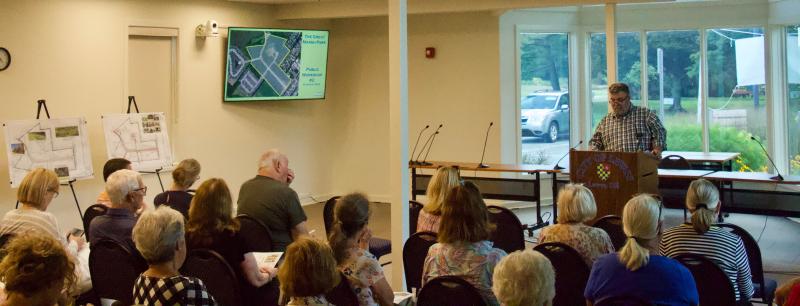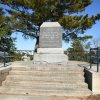Lewes forms plan for Great Marsh Park

“I think it’s important to remember that if we don’t get a master plan that is approved by the state, we could lose this 66 acres ... if it goes to a developer, we’re just going to lose that 66 acres,” Lewes Parks and Recreation Commission Chair Janet Reeves reminded the public Aug. 15.
Lewes is gathering input and working with an environmental engineering firm on a master plan for their largest public park to ensure that doesn’t happen. Workshops were held June 7 and Aug. 4, followed by a presentation to the parks and rec commission.
Barry Dunkin, Great Marsh Park commissioner, has repeatedly reminded residents the master plan is a conceptual practice. Rodney Robinson and other commissioners echoed that philosophy, explaining they are currently in the research and planning stage. Dunkin said projects being discussed will take place over several years, not all at once. Projects will minimally impact and restore the native, natural beauty of the area.
Eric Wahl of Pennoni Associates, who led the two public workshops, presented his firm's ideas and suggestions Aug. 15. Wahl broke down why a level of care is needed in the area, how to minimize impact and preserve nature, explaining the historical and current ecosystem of the park.
Prior to colonization, Great Marsh Park was a northern pin oak forest and a southern mixed pin oak forest. Due to a process called succession, the area will eventually return to its previous form. Research indicates only a few species would survive in such an environment because limited amounts of light penetrate the mature canopy. While public comments called for nature to take its course, humans have already intervened and introduced invasive species and impervious surfaces, and developed massive areas around the natural section. Officials say management of the area is necessary at this point.
“A lot of people have a misconception that they should let nature take its course, and that’s really the worst thing to do out here – abandon it – because that’s what’s been happening,” Robinson said.
Ian McHarg’s 1969 book “Design with Nature” provided much of the framework Wahl used in his concepts. McHarg suggests that it is best to exemplify the natural world and native species rather than control and exploit the environment. Great Marsh Park has Osage orange tree hedgerows only because the area was once a farm, and the tree bearing inedible fruit also produces trunks and branches that act as natural fencing. Wahl said those trees are part of the area’s history and should be preserved, but cleaned up. Bradford pears need to be removed because, as an invasive species, they interfere with the health of the native species.
“Invasives get up earlier and go to bed later and beat the heck out of the natives, and yet they serve no purpose,” said Commissioner Harry Keyser.
Included in the environmental management plan were not only steps to remove invasive species, but also create new natural elements in an attempt to satisfy the public’s desire for preservation. Natural remedies for stormwater management are to replace a concrete swale with a bioswale, and to create wetlands and rain gardens. In addition to cleaning up the Osage orange tree hedgerows and removing invasive species, a meadow would be installed. Wahl said meadows are an incredibly important resource for pollinators and birds, and should be mowed at precise times of the year to eliminate weeds and encourage growth.
Using McHarg’s concept of layering, Wahl was able to identify environmental, accessibility and lighting concerns unique to each area. The circulation plan featured potential gathering areas around the park, along with transportation routes. The roadways would remain the same, but there are proposed walking paths to connect to existing paths and create new ones.
Current designs for the gathering spaces focus on nature, education and art. During the public workshops, requests were made from birdwatchers to create low-impact structures elevated from the marshland. Residents also asked to have more learning opportunities available for children. Wahl discussed an elevated boardwalk for birdwatchers above the wetland area along Park Road, along with an educational pavilion just outside the dog park. Nature sculptures, crafted with branches and twigs, were another idea proposed along walking trails.
In discussions with Reeves, Wahl discovered that Great Marsh Park hasn’t historically had a budget, but officials say that needs to change. While nothing has been budgeted yet, there will be costs associated with implementing and maintaining ideas stemming from the master plan. Reeves and Dunkin said there are a considerable amount of grants available. Reeves said Lewes has done well in the past to obtain those grants, but the city is still responsible for the management of the park.
“I think any time you build a park or have a park, you need to maintain it, and, yes, it will cost money,” Dunkin said.
Lewes has successfully received the Urban and Forestry Grant and the Outdoor Parks and Recreation Trails Grant for previous ventures. The latter recently paid for the refurbishment of the Canalfront Park athletic courts and playground at George H.P. Smith Park.
Commissioners will continue discussions on the master plan with a final draft likely coming in October.
Aaron Mushrush joined the sports team in Summer 2023 to help cover the emerging youth athletics scene in the Cape Region. After lettering in soccer and lacrosse at Sussex Tech, he played lacrosse at Division III Eastern University in St. David's, PA. Aaron coached lacrosse at Sussex Tech in 2009 and 2011. Post-collegiately, Mush played in the Eastern Shore Summer Lacrosse League for Blue Bird Tavern and Saltwater Lacrosse. He competed in several tournaments for the Shamrocks Lacrosse Club, which blossomed into the Maryland Lacrosse League (MDLL). Aaron interned at the Coastal Point before becoming assistant director at WMDT-TV 47 ABC in 2017 and eventually assignment editor in 2018.




















































